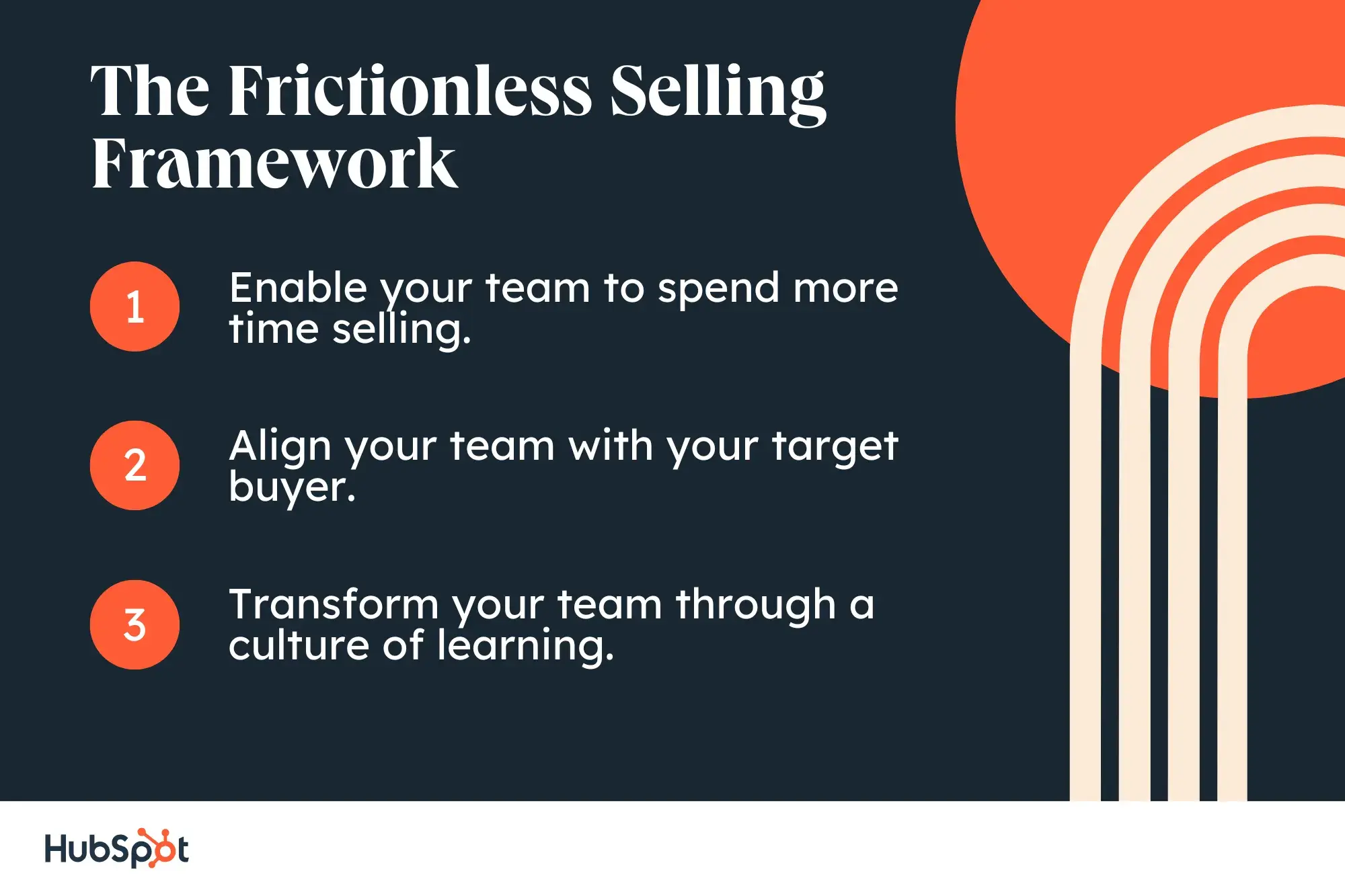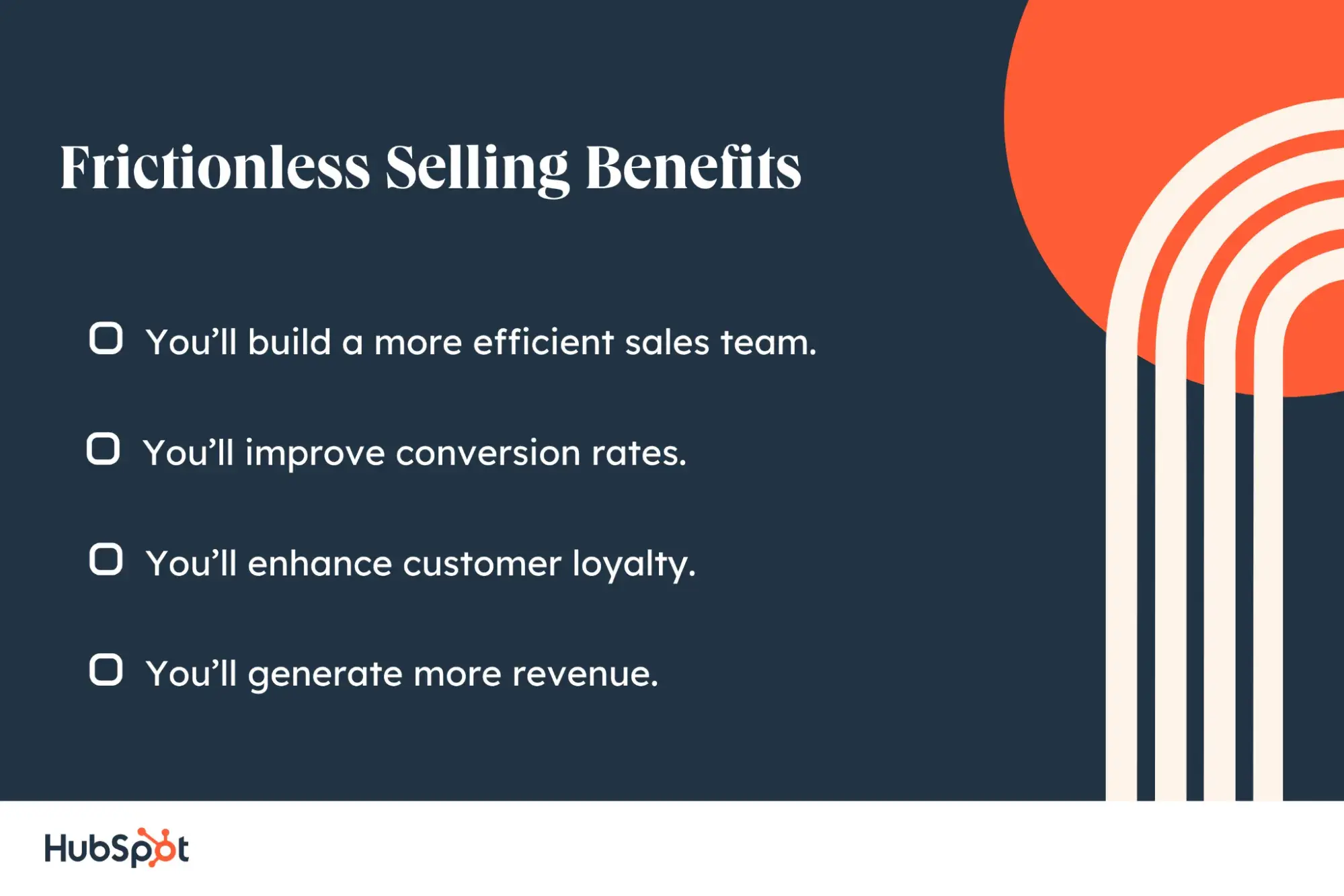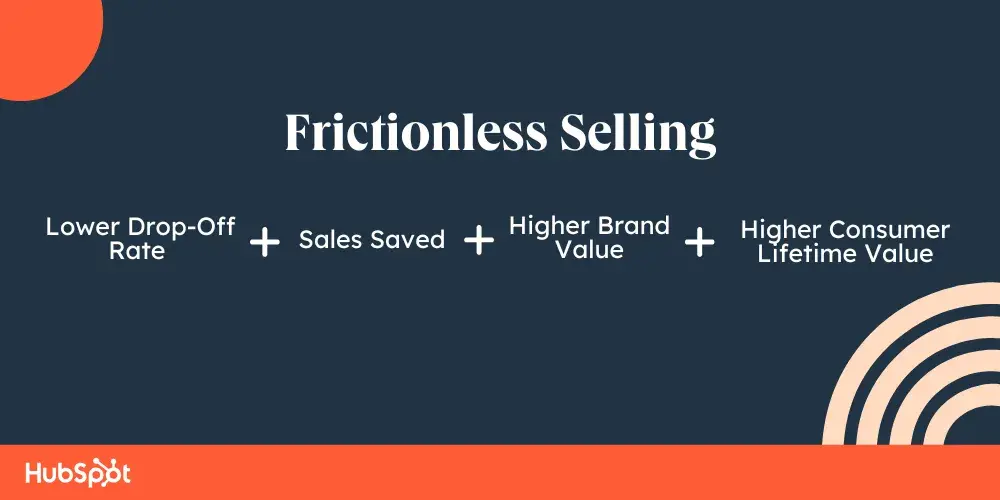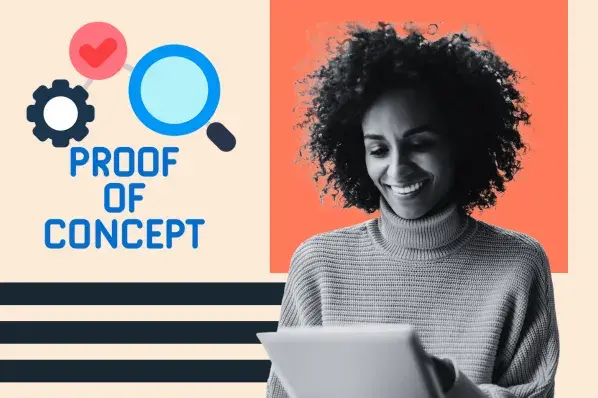Table of Contents
- What is frictionless selling?
- The Frictionless Selling Framework
- How to Reduce Friction in Sales
- Why Use the Frictionless Selling Method?
What is frictionless selling?
In case the name didn’t tip you off, frictionless selling is an approach to sales centered around — you guessed it — minimizing friction. That means implementing strategies to mitigate the objections, obstacles, complexities, and distractions that threaten to derail deals as they flow through the sales funnel.
The idea is to make the sales process as easy and helpful as possible for the customer, which is why frictionless selling is built around a consultative, collaborative approach instead of a transactional one.
Of course, you’ll never be able to achieve 100% frictionless selling, but the goal here is to remove as many hurdles as possible. By decreasing friction, you multiply the output of your sales reps without demanding more input — which can have a significant impact on their close rates.
If you’re already sold on frictionless sales, I highly recommend taking a deep dive into HubSpot’s Frictionless Sales Course and earning a certification. Otherwise, read on for a quick overview of the three phases of implementation, a few examples from my own experience, and a brief exploration of the benefits.
The Frictionless Selling Framework
Whenever I see the word “framework,” I’m ready for things to get overly complicated. Luckily, that’s not the case, according to HubSpot’s frictionless selling framework. What are the phases of the frictionless selling framework? Simple:

Let’s take a closer look at these individual stages and discuss specific tips you can apply in each one.
1. Enable
In many sales teams, reps — particularly less experienced ones — struggle to allocate their time in the most efficient way. Without clear strategies, their random and start/stop outreach is essentially looking for a needle in a haystack.
The best way to remove this type of friction is to help salespeople prioritize their efforts and spend more time selling effectively. How do you do this?
- Scrutinize your sales processes. Do they need to be updated? How can they be improved to maximize productivity?
- Evaluate your sales tools and technologies. Are there any redundancies? Are there any gaps that are compromising the team’s effectiveness? Are there any integrations that the team should be relying on to streamline the process?
- Take a closer look at reps’ day-to-day activities. What tasks are reps spending the most time on? What are the most painful parts of the sales process? What basic tasks can be automated so that reps can focus on more important revenue-generating or relationship-building activities?
Pro tip: Self-reporting (i.e., getting reps to provide feedback on what activities they spend the most time on) might be an easy option, but it isn’t always the most accurate. In my own experience, boring tasks like updating my CRM feel like they take forever, but in reality, it’s a blip.
For more sophisticated insights, get your reps to start using a time tracker app such as HubStaff. These kinds of solutions enable your team to track their hours more reliably and improve their time management skills. Armed with good data, you can also quickly step in to troubleshoot unproductive tasks or processes.
2. Align
Once you’ve enabled your team with the right processes, tools, and technologies, the next step is to align them with your target buyer. The goal here is to reduce friction and make it easy for your buyer to say “yes” to a sale — or “no” if they’ve been misqualified and aren’t the right fit.
You can do this by:
- Ensure that your team is available 24/7. Instead of only providing support during working hours in your time zone, set up live chat on your website and train freelancers from different countries to work as off-hours sales reps. If your team is always available, you’ve already removed a major source of friction.
- Make it easy for your clients to schedule meetings with you. Use a tool such as Calendly to minimize long email chains about finding time to meet. If you’re a HubSpot user, you can also use the built-in meeting scheduler to create a booking page like mine — it’s free and easy!
- Provide transparent pricing and discounts. The more open and upfront you are about pricing, the more trust you build with your prospect. You also help prospects with insufficient budgets opt out if they slipped through the cracks of your qualification process.
- Make it simple for buyers to cancel. Unless you’re selling something like enterprise software, trying to lock your buyer into a multi-year contract will be a major red flag. Outline clear, reasonable terms and give buyers an out if you don’t deliver what you promise.
Pro tip: I would start with the suggestions above, but they’re by no means the finish line. For more ideas on how to align your team with your target buyer, look through old prospect inquiries and identify which ones turned into quality customer relationships.
For instance, if you identify that many prospects have been asking whether your product can be integrated with another solution, there’s clearly a demand for it. Consider having your product teamwork on that integration so that you can provide a better user experience for your customers — and be able to say “yes” to more high-quality prospects.
According to Burt Lancaster, founder and CEO at edtech provider One to One Plus, “When our customers told us their schools were increasingly reliant on Google for devices, management, and professional development, we responded by building seamless integrations between our software and Google’s suite of education products.”
According to Lancaster, this approach ensures our clients benefit from a fully connected and efficient solution that maximizes their investment.”
3. Transform
The last stage of frictionless selling involves transforming your team by creating a company culture of learning.
Here, you’ll want to:
- Become data-driven. Stop using spreadsheets and start using more sophisticated data reporting tools that give you access to real-time data. Good reporting should be generated automatically — otherwise, it won’t happen at all.
- Encourage mentorship. Provide new or struggling reps with a more experienced mentor. At the very least, they should be equipped with playbooks and other training materials.
- Incentivize internal collaboration. Encourage all your reps to share their learnings and best practices with the rest of the team. Don’t expect this to happen organically — actively incentivize it. I suggest tracking the cost of the initiative and calculate its ROI each quarter.
- Manage less and coach more. Good sales reps don’t need micromanagers to look over their shoulders and confirm they’re hitting arbitrary activity benchmarks. They need coaching to help them shore up their weaknesses and leverage their strengths so they can achieve their goals.
Pro tip: If you want to encourage a culture of learning, it can’t be a top-down decree. Get in the trenches and help your reps identify which parts of the sales process are causing hang-ups (literal and figurative), and then work with them to come up with solutions.
If the sales team owns decisions like software investments, they’re more likely to put in the effort necessary to ensure those investments pay off.
How to Reduce Friction in Sales
The best way to reduce friction in your sales process is to identify the areas that cause delays or leakage in the sales funnel. Once you’ve spotted potential sources of friction, simply prioritize the ones that deliver the most bang for your buck.
Shortly after I started in my current role, I set up a meeting scheduling page. After just one or two occasions going back and forth via email and adding extra days to the sales cycle, I made this a priority. This change would deliver groundbreaking results, but it would deliver positive results in the 15 minutes it took to configure in HubSpot and integrate my Google Calendar. Plus, it was free!
Other improvements simply require your team to adopt sales best practices. Are your reps scheduling follow-up meetings while on the call with a prospect? If not, make this a priority. When I was first starting out in sales, a mentor made this recommendation. I was stunned that I hadn’t thought of it on my own. Don’t take for granted that all your reps know the basics.
As you chip away at the low-hanging fruit, the sources of friction will become more and more complex. Today, our marketing proposals are made pretty much entirely from scratch because we serve lots of different industries, and each client is unique.
As a result, it can take me a few days of back and forth with different specialists on the digital marketing team to deliver a polished and thoughtful proposal. That’s valuable time that should be used to identify and connect with the next prospect. I’m already building templates and investigating dedicated tools like PandaDoc to get from proposal to signature in record time.
Because your sales funnel is unique to your own organization and industry, it will have its own points of friction. Maybe you’re selling in the public sector and need to go through certain government hoops to get a signoff, or maybe you’re selling in a space where a single individual has purchasing authority. Regardless, there will be ways to optimize and improve your processes in service of that lofty aspiration, frictionless selling.
Why Use the Frictionless Selling Method?

I am a strong advocate of this method because of the benefits I’ve personally seen in my own sales career. It’s common sense that salespeople and prospects will be happier with a smoother sales process. Nevertheless, here are a few data-backed reasons to intentionally implement frictionless selling if you’re still on the fence.
You’ll build a more efficient sales team.
With reps spending 70% of their time on non-selling tasks, there’s a lot of room to decrease the friction on the seller’s side to increase their efficiency. If you can find the gaps, redundancies, and areas where automation can take over for your team, you will create a more productive sales team.
You’ll improve conversion rates.
Overly complex selling processes cause friction and turn prospects away. In fact, over 70% of B2B buyers report feeling overwhelmed by the amount of information they receive, the number of reps they talk to, and the various package and pricing options available. If you simplify your sales process, buyers are more likely to follow through, and your conversion rates will improve.
You’ll enhance customer loyalty.
If you provide a frictionless experience, customers are more likely to stick around. We found that 75% of customers will continue doing business with a company that provides excellent service — even after making a mistake.
Not only will your customers stick around, but 75% of them will give positive recommendations to others, keeping your funnel full.
You’ll generate more revenue.
Friction during the selling process leads to prospects giving up and lost sales for companies. In fact, it’s estimated that $22 billion in revenue is lost each year due to friction. By reducing the friction in your sales cycle, you’ll likely capture more business and increase your revenue.
Frictionless selling operates on this simple equation:

Start lowering sales friction today.
In my experience, sales can be fun and rewarding — provided I’m spending my time solving interesting, complex problems.
On the other hand, if we’re not careful, we can find ourselves in a real-life Office Space, spending hours meeting meaningless activity quotas, cross-referencing calendars to find viable meeting times (none of which turn out to work for the prospect), and repeatedly copy-pasting parts of one Google Doc into another until our eyes glaze over.
When I was introduced to the notion of frictionless selling, it immediately resonated. This North Star isn’t something that can be achieved overnight, but I try to make some small bit of progress each week toward a more frictionless process for myself, my team, and my prospects, and I would strongly encourage you to do the same.
Sales Methodology






![I Learned How Sales Champions Drive Deals Forward — Here’s What You Should Know [+ Recent Data]](https://53.fs1.hubspotusercontent-na1.net/hubfs/53/sales-champion-1-20250110-9355712-1.webp)
![Decoding Buying Signals in Sales [+ Examples & What I Learned]](https://53.fs1.hubspotusercontent-na1.net/hubfs/53/buying-signals-1-20250501-3647992.webp)


-3.webp)

